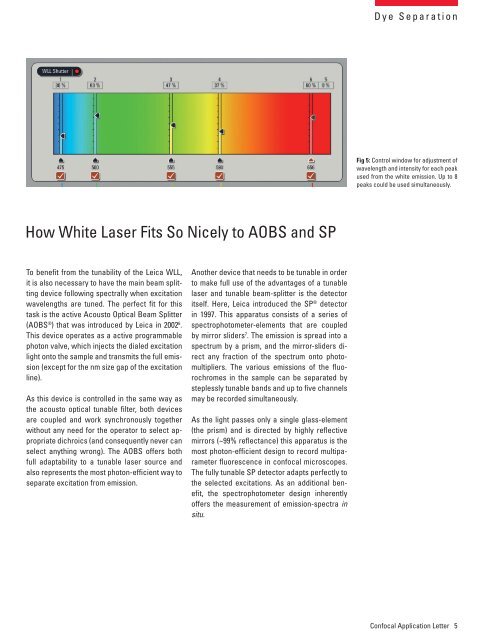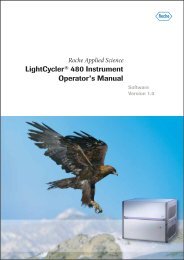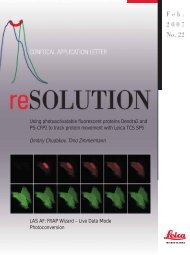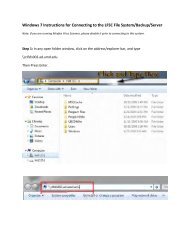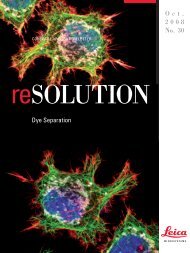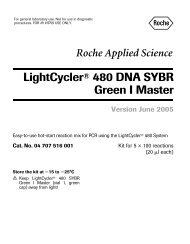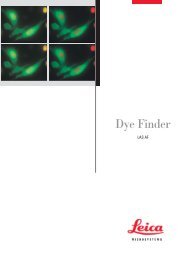Application note: White Light Laser - Department of Cell Biology and ...
Application note: White Light Laser - Department of Cell Biology and ...
Application note: White Light Laser - Department of Cell Biology and ...
Create successful ePaper yourself
Turn your PDF publications into a flip-book with our unique Google optimized e-Paper software.
D y e S e p a r a t i o n<br />
Fig 5: Control window for adjustment <strong>of</strong><br />
wavelength <strong>and</strong> intensity for each peak<br />
used from the white emission. Up to 8<br />
peaks could be used simultaneously.<br />
How <strong>White</strong> <strong>Laser</strong> Fits So Nicely to AOBS <strong>and</strong> SP<br />
To benefit from the tunability <strong>of</strong> the Leica WLL,<br />
it is also necessary to have the main beam splitting<br />
device following spectrally when excitation<br />
wavelengths are tuned. The perfect fit for this<br />
task is the active Acousto Optical Beam Splitter<br />
(AOBS ® ) that was introduced by Leica in 2002 6 .<br />
This device operates as a active programmable<br />
photon valve, which injects the dialed excitation<br />
light onto the sample <strong>and</strong> transmits the full emission<br />
(except for the nm size gap <strong>of</strong> the excitation<br />
line).<br />
As this device is controlled in the same way as<br />
the acousto optical tunable filter, both devices<br />
are coupled <strong>and</strong> work synchronously together<br />
without any need for the operator to select appropriate<br />
dichroics (<strong>and</strong> consequently never can<br />
select anything wrong). The AOBS <strong>of</strong>fers both<br />
full adaptability to a tunable laser source <strong>and</strong><br />
also represents the most photon-efficient way to<br />
separate excitation from emission.<br />
Another device that needs to be tunable in order<br />
to make full use <strong>of</strong> the advantages <strong>of</strong> a tunable<br />
laser <strong>and</strong> tunable beam-splitter is the detector<br />
itself. Here, Leica introduced the SP ® detector<br />
in 1997. This apparatus consists <strong>of</strong> a series <strong>of</strong><br />
spectrophotometer-elements that are coupled<br />
by mirror sliders 7 . The emission is spread into a<br />
spectrum by a prism, <strong>and</strong> the mirror-sliders direct<br />
any fraction <strong>of</strong> the spectrum onto photomultipliers.<br />
The various emissions <strong>of</strong> the fluorochromes<br />
in the sample can be separated by<br />
steplessly tunable b<strong>and</strong>s <strong>and</strong> up to five channels<br />
may be recorded simultaneously.<br />
As the light passes only a single glass-element<br />
(the prism) <strong>and</strong> is directed by highly reflective<br />
mirrors (~99% reflectance) this apparatus is the<br />
most photon-efficient design to record multiparameter<br />
fluorescence in confocal microscopes.<br />
The fully tunable SP detector adapts perfectly to<br />
the selected excitations. As an additional benefit,<br />
the spectrophotometer design inherently<br />
<strong>of</strong>fers the measurement <strong>of</strong> emission-spectra in<br />
situ.<br />
Confocal <strong>Application</strong> Letter 5


